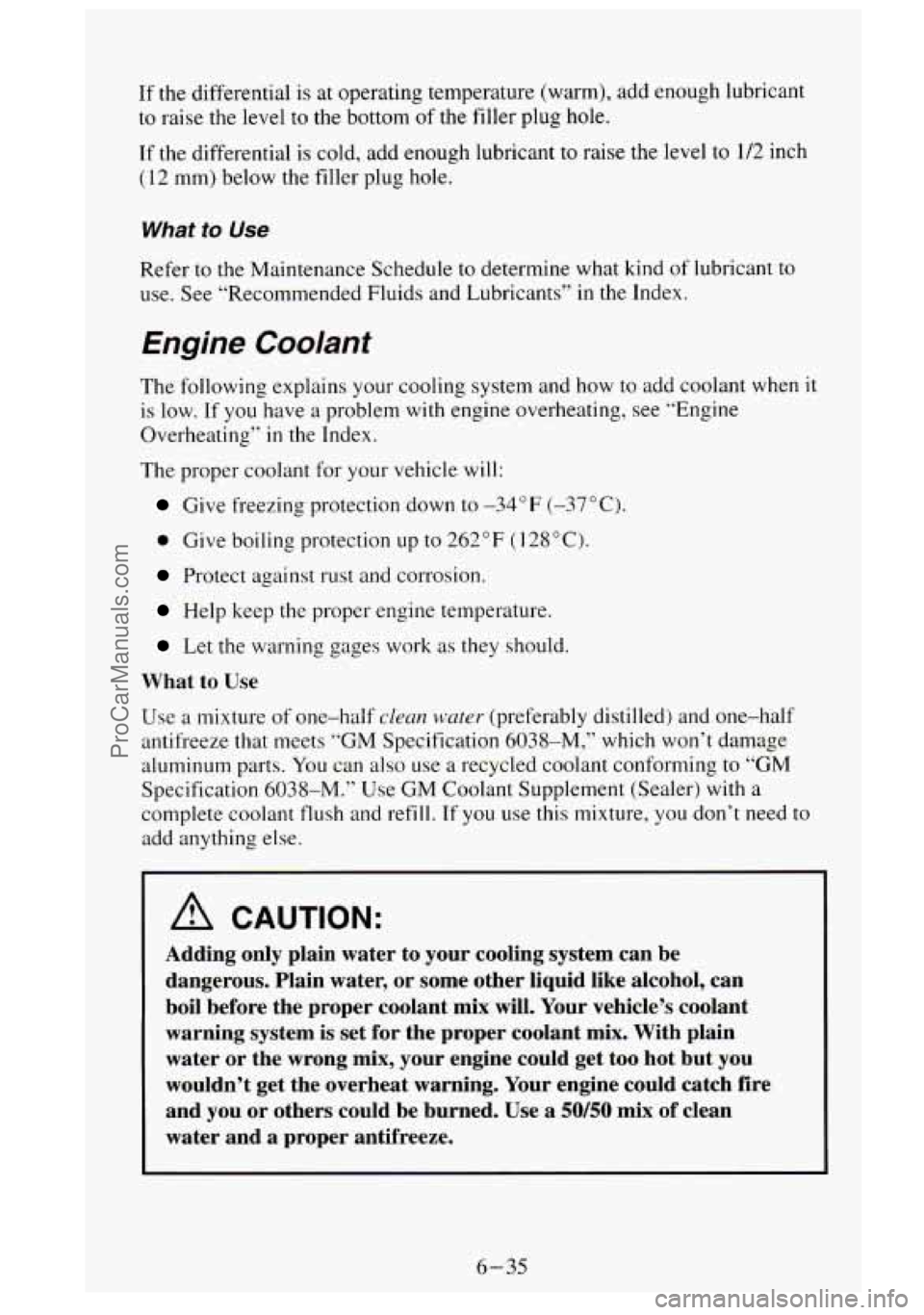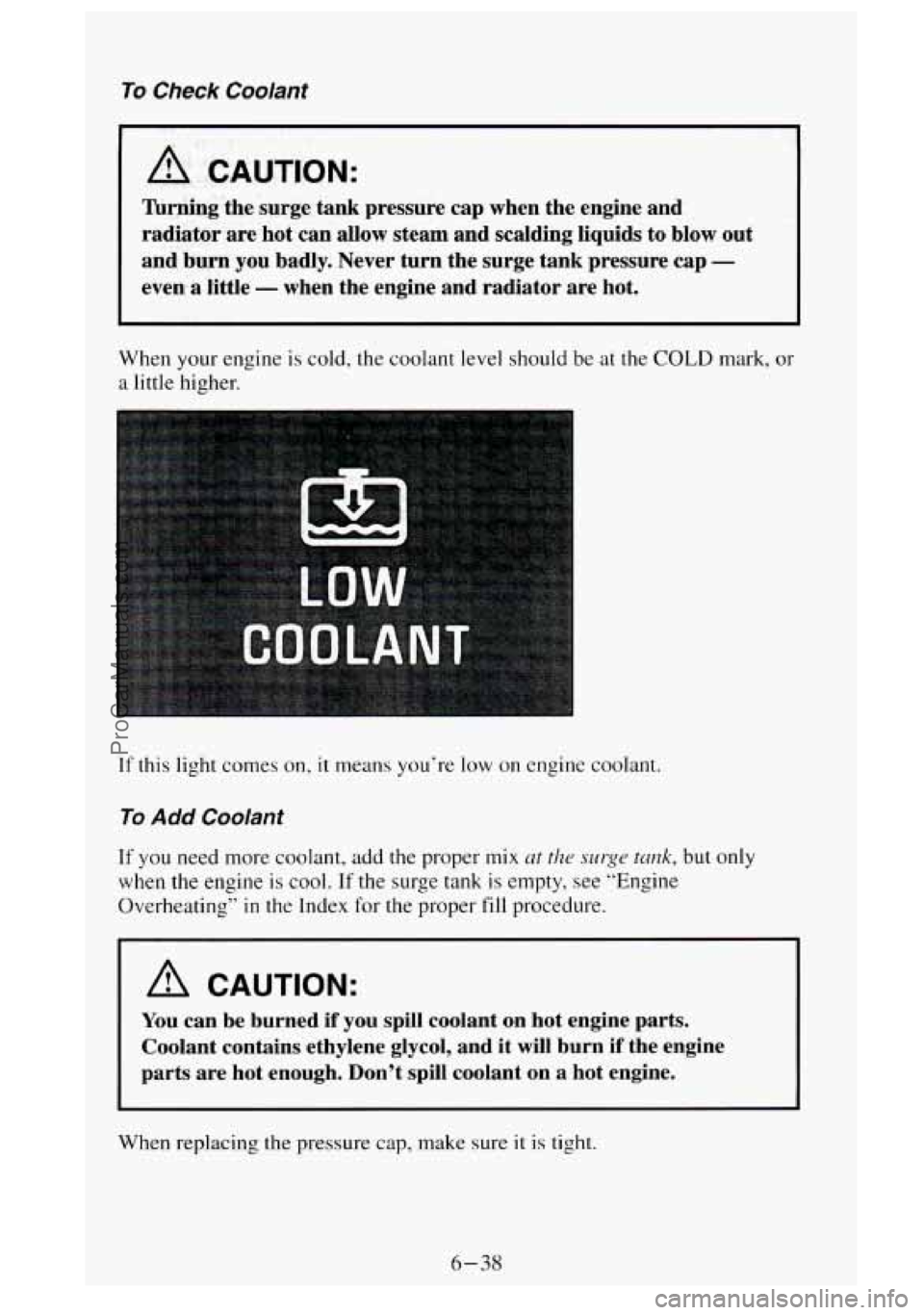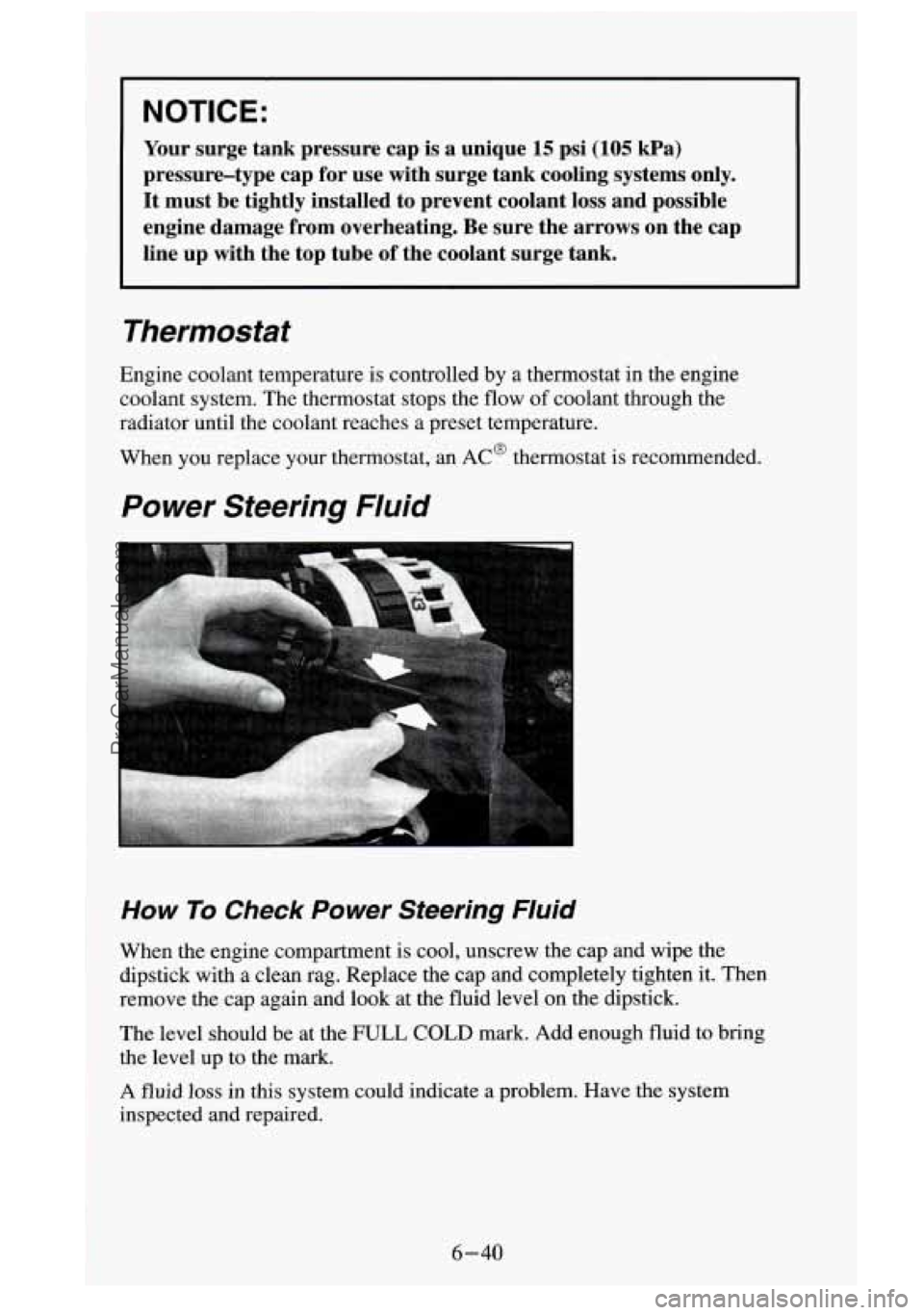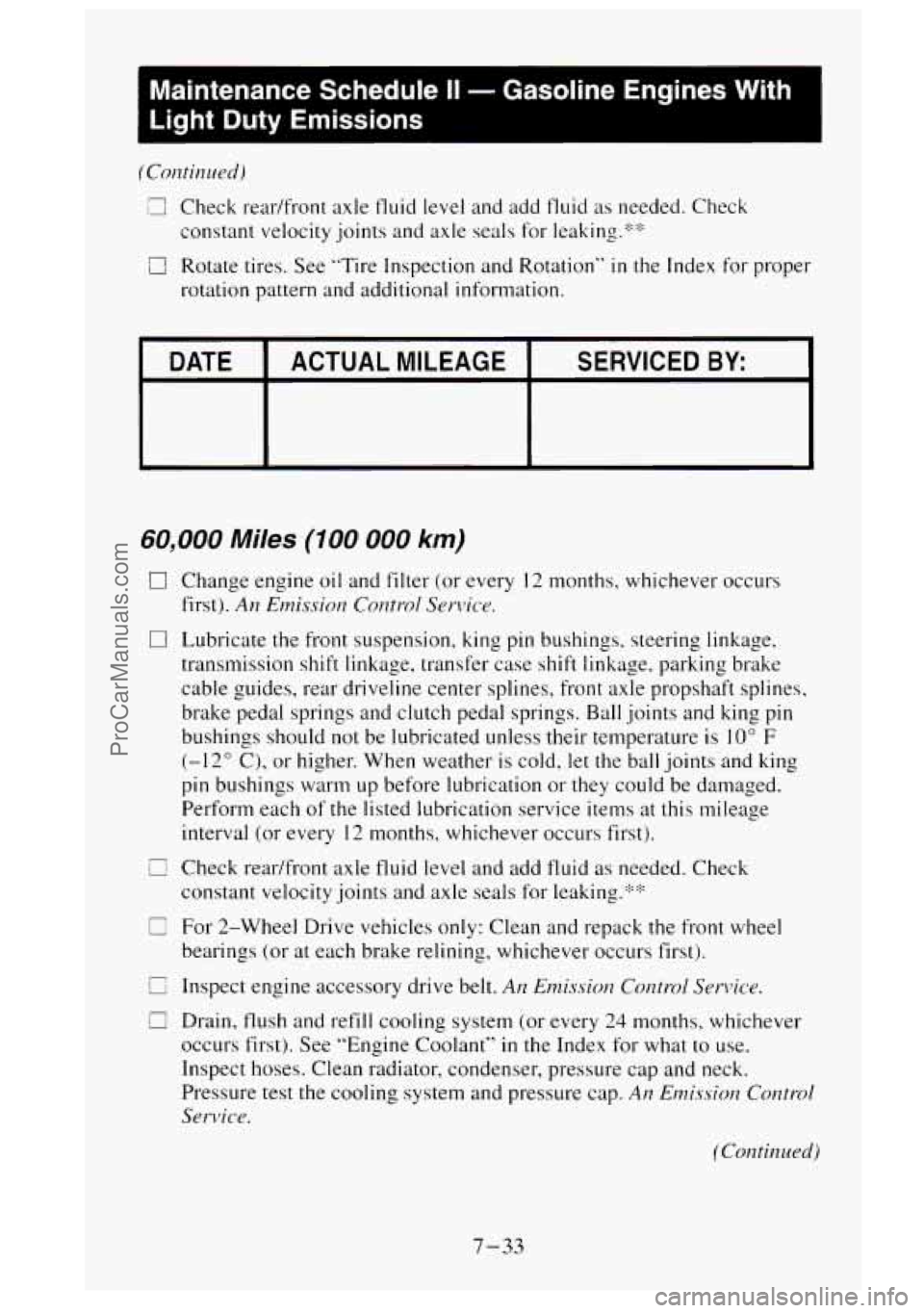1995 GMC SIERRA coolant level
[x] Cancel search: coolant levelPage 301 of 488

If the differential is at operating temperature (warm), add enough lubricant
to raise the level to the bottom
of the filler plug hole.
If the differential is cold, add enough lubricant to raise the level to
1/2 inch
( 12 mm) below the filler plug hole.
What to Use
Refer to the Maintenance Schedule to determine what kind of lubricant to
use. See “Recommended Fluids and Lubricants” in the Index.
Engine Coolant
The following explains your cooling system and how to add coolant when it
is low. If you have a problem with engine overheating, see “Engine
Overheating”
in the Index.
The proper coolant for your vehicle will:
Give freezing protection down to -34°F (-37°C).
0 Give boiling protection up to 262°F (128°C).
Protect against rust and corrosion.
Help keep the proper engine temperature.
Let the warning gages work as they should.
What to Use
Use a mixture of one-half cleun water (preferably distilled) and one-half
antifreeze that meets “GM Specification 6038-M,” which won’t damage
aluminum parts.
You can also use a recycled coolant conforming to “GM
Specification 6038-M.” Use GM Coolant Supplement (Sealer) with a
complete coolant flush and refill. If you use this mixture. you don’t need to
add anything else.
A CAUTION:
Adding only plain water to your cooling system can be
dangerous. Plain water, or some other liquid like alcohol, can
boil before the proper coolant mix will. Your vehicle’s coolant
warning system
is set for the proper coolant mix. With plain
water or the wrong mix, your engine could get too hot but
you
wouldn’t get the overheat warning. Your engine could catch fire
and you or others could be burned. Use
a 50/50 mix of clean
water and
a proper antifreeze.
6-35
ProCarManuals.com
Page 302 of 488

NOTICE:
If you use an improper coolant mix, your engine could overheat
and be badly damaged. The repair cost wouldn’t be covered by
your warranty.
Too much water in the mix can freeze and crack
the engine, radiator, heater core and other parts.
Some conditions. such as air trapped
in the cooling system. can affect the
coolant level
in thc radiator. Check the coolant level when the engine is cold
and
follow the steps under “Adding Coolant“ for the proper way to add
coolant.
If you have to add coolant more than lour timcs a ycar, have your dealer
check your cooling system.
NOTICE:
If you use the proper coolant, you don’t have to add extra
inhibitors or additives which claim to improve the system. These
can be harmful.
Adding Coolant - Gasoline Engine
The coolant reco\wy
tank is located on the
passenger side
at the
rear comer
of the
engine compartment.
To Check Coolant
When your engine is cold, the coolant level should be at the COLD mark, or
a little higher. When your engine is warm, the level should be up to the
HOT mark, or a little higher.
6-36
ProCarManuals.com
Page 304 of 488

To Check Coolant
A CAUTION:
Turning the surge tank pressure cap when the engine and
radiator are hot can allow steam and scalding liquids to blow out
and burn you badly. Never turn the surge tank pressure cap
-
even a little - when the engine and radiator are hot.
When your engine is cold, the coolant level should be at the COLD mark, or
a little higher.
If this light comes on, it means you’re low on engine coolant.
To Add Coolant
If you need more coolant, add the proper mix ut the surge tmk, but only
when the engine is cool. If the surge tank is empty, see “Engine
Overheating”
in the Index for the proper fill procedure.
A CAUTION:
You can be burned if you spill coolant on hot engine parts.
Coolant contains ethylene glycol, and
it will burn if the engine
parts are hot enough. Don’t spill coolant on a hot engine.
When replacing the pressure cap, make sure it is tight.
6-38
ProCarManuals.com
Page 306 of 488

NOTICE:
Your surge tank pressure cap is a unique 15 psi (105 kPa)
pressure-type cap for use with surge tank cooling systems only.
It must be tightly installed to prevent coolant loss and possible
engine damage from overheating. Be sure the arrows on the cap
line up with the top tube of the coolant surge tank.
Thermostat
Engine coolant temperature is controlled by a thermostat in the engine
coolant system. The thermostat stops the flow
of coolant through the
radiator until the coolant reaches a preset temperature.
When you replace your thermostat, an AC@ thermostat is recommended.
Power Steering Fluid
How To Check Power Steering Fluid
When the engine compartment is cool, unscrew the cap and wipe \
the
dipstick with a clean rag. Replace the cap and completely tighten it. Then
remove the cap again and look at the fluid level on the dips\
tick.
The level should be at the
FULL COLD mark. Add enough fluid to bring
the level
up to the mark.
A fluid loss in this system could indicate a problem. Have the system
inspected and repaired.
6-40
ProCarManuals.com
Page 382 of 488

60,000 Miles (100 000 km)
c;
0
0
0
il
0
Change engine oil and filter (or every 3 tnonths. whichever occurs
first).
AI? Emission Control Service.
Lubricate the front suspension. king pin bushings, steering linkage,
transmission shift linkage, transfer case shift linkage, parking brake
cable guides, rear driveline center splines. front axle propshaft splines.
brake pedal springs and clutch pedal springs. Ball joints and king
pin
bushings should not be lubricated unless their temperature is 10" F
(-12" C), or higher. When weather is cold, let the ball joints and king
pin bushings warm up before lubrication or they could be damaged.
Perform each of the listed lubrication service items at this mileage
interval (or every
6 months, whichever occurs first).
Check rear/fi-ont axle fluid level and add fluid as needed. Check
constant
-\;elociry joint5 and axle seals for leaking.';'';'
For 2-Wheel Drive vehicles only: Clean and repack the front wheel
bearings (or at each brake relining, whichever occurs first).
Inspect engine accessory drive belt.
An Emissiolz Comrol Ssrvice.
Drain, flush and refill cooling system (or every 24 months, whichever
occurs first). See "Engine Coolant"
in the lndex for what to use.
Inspect hoses. Clean radiator, condenser, pressure cap and neck.
Pressure test the cooling system and pressure cap.
,411 Erltission Control
Service.
Replace spark plugs. AI? Emission Control Service..
Replace air cleaner filter. Replace filter more often under dusty
conditions.
Arz Emission Colztrol Service.
Inspect fuel tank, cap and lines for damage or leaks . Inspect fuel cap
gasket for any damage. Replace parts as needed.
A17 E~nission Control
Service. -i-
7-26
ProCarManuals.com
Page 386 of 488

0
0
0
0
0
Check readfront axle fluid level and add fluid as needed. Check
constant velocity joints and axle seals for leaking.*’*’
For 2-Wheel Drive vehicles only: Clean and repack the front wheel
bearings (or at each brake relining, whichever occurs first).
Drain, flush and refill cooling system (or every
24 months, whichever
occurs first). See “Engine Coolant”
in the Index for what to use.
Inspect hoses. Clean radiator, condenser, pressure cap and neck.
Pressure test the cooling system and pressure cap.
AI1 Emissiorr Cor?tro/
Se n?ic.e.
Replace spark plugs. Au Emissiorz Control Senice.
Replace air cleaner filter. An Emissiorl Cofltrol Service.
DATE SERVICED BY: ACTUAL
MILEAGE I
37,500 Miles (62 500 km)
0 Change engine oil and filter (or every 12 months, whichever occurs
first).
An EmissioM Control SorLice.
0 Lubricate the front suspension, king pin bushings, steering linkage,
transmission shift linkage, transfer case shift linkage, parking brake
cable guides, rear driveline center splines. front axle propshaft splines,
brake pedal springs and clutch pedal springs. Ball joints and king pin
bushings should
not be lubricated unless their temperature is 10” F
(-12” C), or higher. When weather is cold, let the ball joints and king
pin bushings warm
up before lubrication or they could be damaged.
Perform each of the listed lubrication service items at this mileage
interval
(or every 12 months, whichever occurs first).
7-30
ProCarManuals.com
Page 389 of 488

Maintenance Schedule I1 - Gasoline Engines With
Light Duty Emissions
(Continued)
E Check rear/front axle fluid level and add fluid as needed. Check
constant velocity joints and axle seals for leaking.:!::!:
3 Rotate tires. See "Tire Inspection and Rotation" in the Index for proper
rotation pattern and additional information.
DATE SERVICED BY: ACTUAL MILEAGE L
60,000 Miles (100 000 km)
0
n
C
El
Change engine oil and filter (or every 12 months, whichever occurs
first).
An Emission Control Service.
Lubricate the front suspension, king pin bushings. steering linkage,
transmission shift linkage, transfer case shift linkage, parking brake
cable guides, rear driveline center splines, front axle propshaft splines,
brake pedal springs and clutch pedal springs. Ball joints and king pin
bushings should not be lubricated unless their temperature is
10" F
(-12" C), or higher. When weather is cold, let the ball joints and king
pin bushings warm up before lubrication or they could be damaged.
Perform each
of the listed lubrication service items at this mileage
interval (or every
12 months. whichever occurs first).
Check readfront axle fluid level and add fluid as needed. Check
constant velocity joints and axle seals for leaking.'%*
For 2-Wheel Drive vehicles only: Clean and repack the front wheel
bearings
(or at each brake relining, whichever occurs first).
Inspect engine accessory drive belt.
An Enzission Control Senice.
Drain, flush and refill cooling system (or every 24 months, whichever
occurs first). See "Engine Coolant"
in the Index for what to use.
Inspect hoses. Clean radiator, condenser, pressure cap and neck.
Pressure test the cooling system and pressure cap.
AH Emissio~ Control
Service.
7-33
ProCarManuals.com
Page 411 of 488

Maintenance Schedule II - Gasoline Engines With
Heavy Duty Emissions
24,000 Miles (40 000 km)
0
Change engine oil and filter (or every 12 months, whichever occurs
first).
AI? Emission Control Senice.
Lubricate the front suspension. king pin bushings, steering linkage,
transmission shift linkage, transfer case shift linkage, parking brake
cable guides, rear driveline center splines, front axle propshaft splines,
brake pedal springs and clutch pedal springs. Ball joints and king pin
bushings should not be lubricated unless their temperature
is 10" F
(-12" C), or higher. When weather is cold, let the ball joints and king
pin bushings warm up before lubrication or they could be damaged.
Perform each of the listed lubrication service items at this mileage
interval (or every
12 months. whichever occurs first).
Check readfront axle fluid level and add fluid as needed. Check
constant velocity joints and axle seals for leaking.'k'*
Inspect engine accessory drive belts
(or every 24 months. whichever
occurs first).
An Emission Control Service.
Drain, flush and refill cooling system (or every 24 months, whichever
occurs first). See "Engine Coolant'' in the Index for what
to use.
Inspect hoses. Clean radiator, condenser, pressure cap and neck.
Pressure test the cooling system and pressure cap.
An Enzission Control
Service.
Replace air cleaner filter. An Ettzissiorz Control Service.
Replace fuel filter. An Emission Control Service.
DATE SERVICED BY: ACTUAL MILEAGE L
i
7-55
ProCarManuals.com